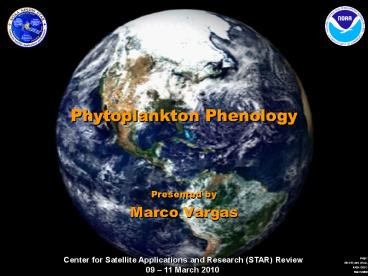Phytoplankton Phenology PowerPoint PPT Presentation
Title: Phytoplankton Phenology
1
Phytoplankton Phenology
- Presented by
- Marco Vargas
2
Requirement, Science, and Benefit
- Requirement / Objective
- Ecosystems
- Increase number of regional coastal and marine
ecosystems delineated with approved indicators of
- ecological health and socioeconomic
benefits that are monitored and understood. - Increase portion of population that is
knowledgeable of and acting as stewards for
coastal and marine - ecosystems.
- Climate
- Understand and predict the consequences of
climate variability and change on marine
ecosystems - Science
- Can we model the annual cycles of phytoplankton
and describe the timing and magnitude of
phytoplankton - biomass in the open ocean?
- Can we relate changes in phytoplankton biomass to
oceanic variables? - Are there any trends in the timing and magnitude
of phytoplankton biomass? - Benefit
- National Ocean Service and their customers, Ocean
Color Community - Assessing marine ecosystem response to climate
change - Ability to monitor and detect changes in
distribution of phytoplankton in marine
ecosystems
3
Challenges and Path Forward
- Science challenges
- Improve atmospheric correction
- Need longer time-series
- Next steps
- Explore different time/spatial resolutions to
maximize resolved features - Extend study to global oceans
- Develop equivalent algorithms to process
NOAA-generated - VIIRS/NPP
- Transition Path
- Generate experimental version from MODIS/SeaWIFS
- Generate operationally from MODIS/SeaWIFS for
global ocean - Include algorithm development/validation for
VIIRS/NPP to provide - product continuity
- Our goal is to transition the phytoplankton
phenology product to operations within the next
few years. - End users National Ocean Service and their
customers, Ocean Color Community
4
Modeling of Bloom Data
- Daily SeaWIFS global chlorophyll (4 km res) is
- aggregated to pentad (five-day) means with a
- spatial resolution of 3x3 lat/lon
- Highly non Gaussian
- Bloom data are non-negative
- GLMs (Generalized Linear Models) for
- Gamma distributed data.
- The chlorophyll amount Y is modeled using a
- Gamma GLM with the canonical log link
- Spatial distribution of the eight models
constructed - to represent the annual cycle of chlorophyll in
the - study area
Distribution of example grid-box D with estimated
distributions overlaid. The black line represents
a Gaussian distribution and the red line
represents a Gamma distribution
5
Generalized Linear Models (GLMs) for Gamma
distributed data
6
Determination of Phenological Markers
Spatial distribution of (A) bloom onset, (B)
bloom maturity, (c) start of bloom decay, and (d)
bloom termination

